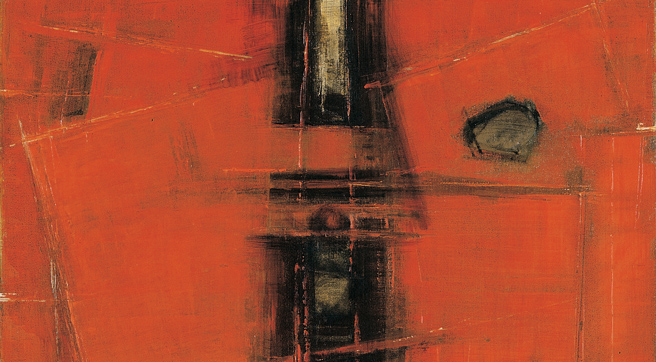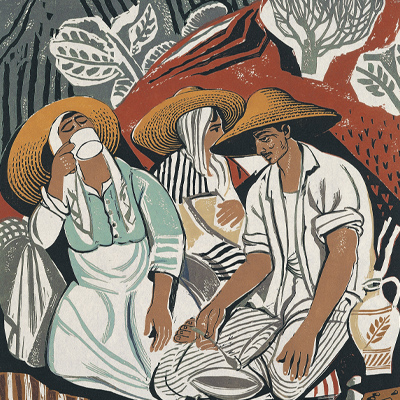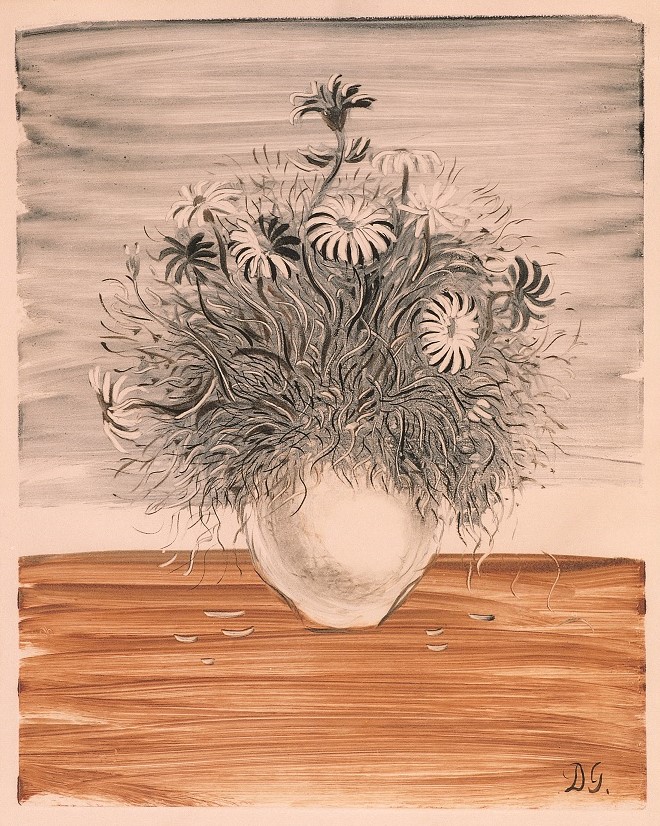Paris Prekas, Red Icarus
Red Icarus by Paris Prekas is an abstract expressionism painting, themed after the mythological hero Icarus and the freedom that he symbolises. The painter and sculptor was deeply influenced by Ancient Greek art, the simplicity of which is reflected on the painting. The composition is also characterised by the intensity of geometry and colour.
Austerity and explosive colour
Red Icarus is a typical example of Paris Prekas’ work.
As part of a sequence of paintings themed after Icarus, it highlights the systematic nature of the artist and the strict organisation of his work in thematic units. At the same time, it demonstrates his continuous and highly successful balance between realism and abstraction.
A succession of red tones develops on the entirely square canvas. The light-coloured background is followed by black and the bold, explosive red.
The figure of Icarus
The black figure of Icarus is placed perpendicularly at the centre of the composition. As such, it breaks up the complete schematic harmony and disrupts the colour representation.
Icarus is not rendered in a descriptive, detailed manner, as is usually the case with mythological themes. Prekas avoids dramatisation. In contrast, he prefers to represent the composition in a simple, austere manner.
Icarus as a symbol of freedom
Within Greek mythology and its symbolisms, Prekas discovered the figure of Icarus, a potent symbol for the eternal theme of freedom.
The power of this correlation pushed him to create an entire sequence of paintings and sculptures inspired by the same hero.
Influences and artistic style
The painting draws from the simplicity of Ancient Greek art, which never ceased to impress Prekas. At the same time, the influence of European expressionism is also evident.
As with most pieces in that sequence, Red Icarus falls under abstract expressionism. However, it is also typified by a peculiar sense of Realism, while still remaining true to its geometric style.
His life in a nutshell
Paris Prekas (1926-1999) was born in Athens and hailed from the island of Santorini. He studied Painting at the Athens School of Fine Arts from 1948 until 1952.
In 1963, with a French government scholarship, he continued his studies in Paris, where he lived and worked for a large part of this life.
After the fire disaster in Notre Damme in 2019, his wife Meropi Preka donated more than 40 of his works for auction, with proceeds going to restore the iconic church.
Artistic influences
At the Athens School of Fine Arts, Prekas studied under Dimitrios Biskinis and Andreas Georgiadis, 2 representatives of academic realism, as well as under Umberto Argyros.
The artist was deeply influenced by the models of Ancient Greek sculpture and pottery, which he incorporated in his paintings.
Favourite themes
Prekas was a multifaceted artist. He worked in painting, sculpture, engraving, and architectural interior and exterior design.
Initially his paintings were centred around landscapes. Then he turned to the world of mythology and to the Greek tradition and reality.
Inspired by Ancient Greek texts, he created complete thematic circles, such as horse, ship, horsemen, winner and loser.
Artistic style
Prekas’ artistic production moved between abstraction and constructivism.
With Ancient Greek art as a starting point, he created pieces where the values of the past were strongly present. He moved on to abstract and geometric compositions. His works are marked by accented shapes.
His sculptures are dominated by decorative relief compositions and geometric elements, which are harmoniously structured on the bearing surfaces.
A recognised artist
Prekas presented his work in solo and group exhibitions. He participated in international Biennales (Paris 1959, São Paulo 1965, Alexandria 1968), receiving numerous accolades.
He was honoured with the Athens School of Fine Arts award in 1952, the 1st Prize for Painting in Athens in 1958 and the 2nd Prize in Paris in 1959, and also received the Silver Medal of the City of Paris in 1962.
A number of his works are installed in public spaces in Greece.
Red Icarus by Paris Prekas is referenced in the following Alpha Bank publications:
- The Alpha Bank Collection. Greek Art from 1920 until Today, edited by Irene Orati. The publication accompanied the Art Collection’s exhibition at the Macedonian Museum of Contemporary Art in Thessaloniki.
Buy the publication The Alpha Bank Collection. Greek Art from 1920 until Today on the Alpha Bank eshop. - The Alpha Bank Collection. Paintings – Prints – Sculptures, edited by Irene Orati. The publication marks the 125th anniversary of Alpha Bank.
Buy the publication The Alpha Bank Collection. Paintings – Prints – Sculpture (only available in Greek) on the Alpha Bank eshop. - Mazi magazine (issue 26, July-August 2016).
The Alpha Bank Art Collection is not open to the public.
Research visits to the Art Collection can be organised upon request.
Contact us to book your visit.







